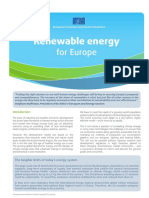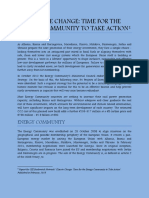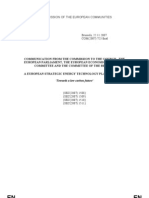Rexel International Regulation Review June 2011
Rexel International Regulation Review June 2011
Uploaded by
Energy 3.0Copyright:
Available Formats
Rexel International Regulation Review June 2011
Rexel International Regulation Review June 2011
Uploaded by
Energy 3.0Copyright
Available Formats
Share this document
Did you find this document useful?
Is this content inappropriate?
Copyright:
Available Formats
Rexel International Regulation Review June 2011
Rexel International Regulation Review June 2011
Uploaded by
Energy 3.0Copyright:
Available Formats
European Energy Efficiency Action Plan (EEAP)
June 2011
Topic The European Commission adopted on 8 March 2011 a European Energy Efficiency Action Plan (EEAP). The EEAP will succeed to the 2006 Energy Efficiency Action Plan which will expire in 2012 and contains a set of mesures aimed at strengthening energy efficiency in the EU by 2020. Challenges Reaching a target of saving 20% of primary energy consumption by 2020 at EU level The EEAP is designed to fill in the loopholes in the 2006 Action Plan and to propose new orientations and measures to reach a target of saving 20% of primary energy consumption by 2020, as provided by the 2008 Climate Change Package. According to the Commissions projections, based on current trends, the EU would reach a saving of only 10% by 2020. The measures proposed by the EEAP have the potential to reduce annual greenhouse gas emissions by 740 million tons over the period 2013-2020. Supporting the development of the green economy and greens jobs
http://www.electrical-efficiency.com
Beyond its energy and environmental dimension, the EEAP could have a strong economic and social impact : it has the potential to generate financial savings of up to 1000 euros per household every year and to create up to 2 million jobs in the EU. Taking into account the whole energy chain The EEAP proposes a new approach covering the whole energy chain from generation to end-use, including transmission and distribution. Promoting an approach based on energy efficency in key sectors Industry : improvement to the efficiency of power and heat generation ; mandatory energy audits for large companies ; measures to introduce energy management systems ; additional ecodesign measures on industrial products. Energy efficiency services : introduction of national energy saving obligation schemes ; better information on energy services ; increase of the transparency of the ESCO market through lists of accredited energy service providers and model contracts ; better access of providers to financial resources. Public sector : high energy efficiency standards in public spending ; annual 3% refurbishment in public buildings ; clarification of the energy performance contracting legal framework. Buildings : introduction of measures to address the split of incentives issue between owners and tenants.
Implementing horizontal measures to support energy efficiency - Consumers : improved information to consumers ; support to the deployment of smart grids and smart meters ; support to energy and resource efficient appliances ; support to energy labels. - Financing : support to private investments through new financing tools. - Training : support to Member States in assessing training needs for the construction sector ; development of strategies to foster effective training schemes. - Supporting SMEs : incentives to invest in energy efficiency technologies ; support of the exchange of best practices and benchmarking tools. - Supporting energy efficiency on the ground Key points of the debate The main open question concerns the proposal of legally binding national targets for energy efficiency combined with monitoring mecanisms like the one set up for the promotion of the use of energy from renewable sources. The three EU institutions (Commission, Council of Ministers and European Parliament) have divergent positions on this matter. In its initiative report adopted on 15 December 2010, the European Parliament supports the definition of binding energy efficiency targets of at least 20% by 2020 ; for the EP, binding targets are the only way to reach significant progress in this field. On the
http://www.electrical-efficiency.com
contrary, the Council of Ministers reaffirmed in February 2011 that it was opposed to the introduction of any national or sectoral binding objective. At this stage, the EEPA does not set binding objectives ; however, based on an assessment of progress made in the frame of the national energy efficiciency programmes set by the Member States, the European Commission will propose in 2013, if deemed necessary, legally binding national targets for 2020. In such a case, several criteria should be taken into account to define the objectives of each Member State: the different starting points; the economic performance ; the existence of national provisions in this field. In this regards, France has set up the Rglementation Thermique 2012 (RT2012) which aims at limiting the primary energy consumption in new residential and commercial buildings.
Next steps The EEAP adopted on 8 March 2011 by the European Commission was transmitted to the European Parliament and to the Council for consideration. Member States should adopt conclusions on the Communication during the Transport, Telecoms and Energy Council of Ministers meeting of 10 June 2011. The European Commission will adopt on 22 June 2011 a legislative proposal revising and merging Directive 2006/32/EC on energy end-use efficiency and energy services and Directive 2004/8/EC on the promotion of cogeneration based on useful heat demand in the internal energy market. New eco-design and labelling measures will be proposed in 2011 and 2012 ; innovative financing mecanisms aimed at strengthening energy efficiency will also be presented in the next months.
Useful Links Website of Directorate-General for Energy (European Commission) http://ec.europa.eu/energy/efficiency/action_plan/action_plan_en.htm
You will find all the International Review about Regulations in Electrical Efficiency on the web site :
http://www.electrical-efficiency.com/category/regulation/rexel-international-review/
http://www.electrical-efficiency.com
You might also like
- Moa Investment ProposalDocument4 pagesMoa Investment ProposalTim Smirnoff100% (4)
- 2014 Energy Efficiency CommunicationDocument27 pages2014 Energy Efficiency CommunicationkktayNo ratings yet
- 2009 Eeap Background Document PDFDocument8 pages2009 Eeap Background Document PDFIgor NeagaNo ratings yet
- EU Energy Policy PrinciplesDocument8 pagesEU Energy Policy PrinciplesCimnaz IsmayilovaNo ratings yet
- Memo For Road Map of Renewable EnergyDocument4 pagesMemo For Road Map of Renewable EnergySaleh Al-TamimiNo ratings yet
- Energy Policy in EUDocument12 pagesEnergy Policy in EUjack_portugaNo ratings yet
- Renewable Energy StrategyDocument10 pagesRenewable Energy Strategydanb1No ratings yet
- Background Paper NZEBDocument25 pagesBackground Paper NZEBsteinman1No ratings yet
- Commission Communication 2013-762 - Implementing The Energy Efficiency Directive - Commission Guidance (En)Document9 pagesCommission Communication 2013-762 - Implementing The Energy Efficiency Directive - Commission Guidance (En)iurii socolNo ratings yet
- Rish Olicies: Paper, Delivering A Sustainable Energy Future For Ireland, A TargetDocument4 pagesRish Olicies: Paper, Delivering A Sustainable Energy Future For Ireland, A TargetSeamus CreedNo ratings yet
- EU Council Conclusions 22 May 2013Document9 pagesEU Council Conclusions 22 May 2013climatehomescribdNo ratings yet
- Environment Energy PolicyDocument18 pagesEnvironment Energy Policydropkick94No ratings yet
- Energy Efficiency in The Industry - Complement For Renewable Energies - Maria Holopainen VTTDocument33 pagesEnergy Efficiency in The Industry - Complement For Renewable Energies - Maria Holopainen VTTCentro de Innovación UC Anacleto AngeliniNo ratings yet
- Wind Energy ContributionDocument104 pagesWind Energy ContributionTown Obio EteteNo ratings yet
- Energyunion Citizens Summary enDocument2 pagesEnergyunion Citizens Summary enCodrut GeorgescuNo ratings yet
- 2014 Neeap en SpainDocument150 pages2014 Neeap en SpainJosemariaSaNo ratings yet
- Energy EfficiencyDocument19 pagesEnergy EfficiencyRetro ParadiesNo ratings yet
- RES Directive SpecialDocument4 pagesRES Directive SpecialNaciye TengilimoğluNo ratings yet
- 2050 EU Energy Strategy ReportDocument7 pages2050 EU Energy Strategy ReportHector Parra MolinaNo ratings yet
- Renewable Electricity Corporate Power Purchase Agreements RoadmapDocument19 pagesRenewable Electricity Corporate Power Purchase Agreements RoadmapHarshita DixitNo ratings yet
- 1 en Act Part1 v16 PDFDocument22 pages1 en Act Part1 v16 PDFMatevz PusnikNo ratings yet
- Meps Call For More Ambitious and Consumer-Focused Energy Targets Beyond 2020Document2 pagesMeps Call For More Ambitious and Consumer-Focused Energy Targets Beyond 2020Monika PerezNo ratings yet
- Energy Efficiency Directive Citizen Summary en PDFDocument1 pageEnergy Efficiency Directive Citizen Summary en PDFIgor NeagaNo ratings yet
- Renewable Energy For Europe (Eng) / Energia Renovable para Europa (Ing) / Energia Berriztagarriak Europan (Ing)Document2 pagesRenewable Energy For Europe (Eng) / Energia Renovable para Europa (Ing) / Energia Berriztagarriak Europan (Ing)EKAI CenterNo ratings yet
- REPowerEU - A PlanDocument5 pagesREPowerEU - A PlansamNo ratings yet
- Energy Audit and Energy CertificationDocument45 pagesEnergy Audit and Energy CertificationGuru PrasadNo ratings yet
- PC 022019 EedDocument12 pagesPC 022019 EedMarouane SbaiNo ratings yet
- 2010 07 02 Energy Strategy Results 0Document11 pages2010 07 02 Energy Strategy Results 0Pablo Puñal FieiraNo ratings yet
- A Comparative Meta-Analysis of Residential Green Building Policies and Their Impact On Overall Energy Consumption PatternsDocument8 pagesA Comparative Meta-Analysis of Residential Green Building Policies and Their Impact On Overall Energy Consumption PatternsJournal of Architectural Design and Construction TechnologyNo ratings yet
- EU-China Energy Magazine 2021 Summer Issue: 2021, #2From EverandEU-China Energy Magazine 2021 Summer Issue: 2021, #2No ratings yet
- Green Paper UeDocument16 pagesGreen Paper UeCarlos JNo ratings yet
- Leaflet Legal FrameworkDocument2 pagesLeaflet Legal FrameworkAlbina TocillaNo ratings yet
- REPowerEU BriefingDocument21 pagesREPowerEU Briefingauberginerouge94No ratings yet
- Denmark r04Document38 pagesDenmark r04kalokosNo ratings yet
- Building PhysicsDocument33 pagesBuilding Physicsothmani rafaaNo ratings yet
- EU Local: Energy ActionDocument32 pagesEU Local: Energy ActionTudor SorbanNo ratings yet
- 31573-2011 WP Cooperation Energy Amended enDocument86 pages31573-2011 WP Cooperation Energy Amended enakanyilmazNo ratings yet
- Energy Policy For MaltaDocument64 pagesEnergy Policy For MaltaJosef Grima DucaNo ratings yet
- EU China Energy Magazine 2022 Christmas Double Issue: 2022, #11From EverandEU China Energy Magazine 2022 Christmas Double Issue: 2022, #11No ratings yet
- European Policies On Climate and EnergyDocument12 pagesEuropean Policies On Climate and EnergyanterogerNo ratings yet
- Electricity Regulation in Spain OverviewDocument28 pagesElectricity Regulation in Spain OverviewBruno GFNo ratings yet
- Energy For Romania From Renewable Resources: Studies in Business and EconomicsDocument5 pagesEnergy For Romania From Renewable Resources: Studies in Business and EconomicsDinu CatalinaNo ratings yet
- Ftu 2.4.7Document5 pagesFtu 2.4.77qswr2gw84No ratings yet
- Energy Community BiHDocument23 pagesEnergy Community BiHIdaNo ratings yet
- European Green Deal Commission Proposes Transformation of EU Economy and Society To Meet Climate AmbitionsDocument5 pagesEuropean Green Deal Commission Proposes Transformation of EU Economy and Society To Meet Climate AmbitionsclarencegirlNo ratings yet
- The EURELECTRIC Energy Wisdom Programme (EWP) : Improving Energy Efficiency Reducing Carbon Emissions Meeting The 2050 ChallengesDocument68 pagesThe EURELECTRIC Energy Wisdom Programme (EWP) : Improving Energy Efficiency Reducing Carbon Emissions Meeting The 2050 ChallengesDimitrios MavromatidisNo ratings yet
- Residential Energy Efficiency Policy in Latvia A Sistem Dynamics ApproachDocument23 pagesResidential Energy Efficiency Policy in Latvia A Sistem Dynamics Approachjhon contrerasNo ratings yet
- Commission of The European CommunitiesDocument32 pagesCommission of The European Communitiesrobnet-1No ratings yet
- EN EN: Commission of The European CommunitiesDocument14 pagesEN EN: Commission of The European Communitiesuakauaka31416No ratings yet
- CZ Neeap Update 2-2016 en 3 PDFDocument95 pagesCZ Neeap Update 2-2016 en 3 PDFApolo FumbujaNo ratings yet
- 030 StatementEnergyClimateDocument7 pages030 StatementEnergyClimateAsha RaniNo ratings yet
- EN EN: European CommissionDocument14 pagesEN EN: European CommissionLim ChintakNo ratings yet
- Energy Efficiency Policy in RomaniaDocument13 pagesEnergy Efficiency Policy in RomaniaGabriela LorenaNo ratings yet
- 2 380 15 - BertoldiDocument12 pages2 380 15 - BertoldikemredserbiaNo ratings yet
- Energy: Reducing Energy Consumption and Eliminating Energy Wastage AreDocument5 pagesEnergy: Reducing Energy Consumption and Eliminating Energy Wastage AreBogdan PopaNo ratings yet
- Call For Proposals 2013: Call Identifier: CIP-IEE-2013 Closing Dates: Wednesday 8 May 2013, 17:00 (Brussels Local Time)Document33 pagesCall For Proposals 2013: Call Identifier: CIP-IEE-2013 Closing Dates: Wednesday 8 May 2013, 17:00 (Brussels Local Time)Anca PuiaNo ratings yet
- Elearning Clean Energy Package 032020Document16 pagesElearning Clean Energy Package 032020AnanyaNo ratings yet
- Intelligent Energy Europe at A Glance 2011Document5 pagesIntelligent Energy Europe at A Glance 2011Μπάμπης ΧρυσοχοΐδηςNo ratings yet
- EU-China Energy Magazine 2020 Christmas Double Issue: 2020, #4From EverandEU-China Energy Magazine 2020 Christmas Double Issue: 2020, #4No ratings yet
- EU China Energy Magazine 2022 April Issue: 2022, #3From EverandEU China Energy Magazine 2022 April Issue: 2022, #3No ratings yet
- ENTSO-E Grid Planning Modelling Showcase for China: Joint Statement Report Series, #4From EverandENTSO-E Grid Planning Modelling Showcase for China: Joint Statement Report Series, #4No ratings yet
- A Mathematical Perspective of Single-Channel Pseudo-Monopulse Tracking Receiver DesignDocument2 pagesA Mathematical Perspective of Single-Channel Pseudo-Monopulse Tracking Receiver DesignjiyamanNo ratings yet
- Redox TitrationDocument10 pagesRedox TitrationJunior Singer DeepNo ratings yet
- Latitude E7250 Ultrabook Owner's Manual en UsDocument52 pagesLatitude E7250 Ultrabook Owner's Manual en UscipyyyyNo ratings yet
- 2020 Mod ListDocument18 pages2020 Mod Listdenilson araujo100% (1)
- Welcome To FritzingDocument1 pageWelcome To FritzingSamantha MoralesNo ratings yet
- Law Thesis Topics PhilippinesDocument8 pagesLaw Thesis Topics Philippinesheatheredwardsmobile100% (2)
- RMO No. 16-2023 FINAL Prescribes Supplemental Guidelines and Procedures On The Implementation of RMO No. 40-2022Document13 pagesRMO No. 16-2023 FINAL Prescribes Supplemental Guidelines and Procedures On The Implementation of RMO No. 40-2022Mrs Pokemon MasterNo ratings yet
- UptkdDocument1 pageUptkdMaría Navarro AparicioNo ratings yet
- LK 90C ImpregnationDocument2 pagesLK 90C ImpregnationTrầnCôngĐuaNo ratings yet
- Bachianas Brasileiras n2 Sax Tenor 1Document2 pagesBachianas Brasileiras n2 Sax Tenor 1JorgeNo ratings yet
- Copyright Page Dissertation ExampleDocument4 pagesCopyright Page Dissertation ExampleBuyAPaperOnlineSingapore100% (1)
- FAO Forage Profile - ChinaDocument63 pagesFAO Forage Profile - ChinaAlbyziaNo ratings yet
- Nông Thái Bảo - HE150030 2Document5 pagesNông Thái Bảo - HE150030 2Bao DucNo ratings yet
- SUN 72M (Sunenergy Monocristalino 370W)Document2 pagesSUN 72M (Sunenergy Monocristalino 370W)grasia77No ratings yet
- 虚拟勒芒规则V2 0Document17 pages虚拟勒芒规则V2 0luyuanNo ratings yet
- PG8 L RB GPMXDocument23 pagesPG8 L RB GPMXnolerek166No ratings yet
- HP All Desktop Price List March 14Document1 pageHP All Desktop Price List March 14sanjay1009No ratings yet
- Filter Design ParameterDocument3 pagesFilter Design ParameteruemaaplNo ratings yet
- The Traditional Accounting Information System ArchitectureDocument14 pagesThe Traditional Accounting Information System ArchitectureAshraf ZamanNo ratings yet
- MV-22B Osprey TestAndEvaluationDocument16 pagesMV-22B Osprey TestAndEvaluationmuhammad haidar razan hilmiNo ratings yet
- Path Planning Using An Improved A-Star AlgorithmDocument4 pagesPath Planning Using An Improved A-Star AlgorithmGergely HornyakNo ratings yet
- Reference Case: TR Arabia Inspection in Saudi Shutdown ProjectDocument2 pagesReference Case: TR Arabia Inspection in Saudi Shutdown ProjectLaxmikant TiwariNo ratings yet
- EV QUESTION BANK With AnswersDocument29 pagesEV QUESTION BANK With AnswersSash Dhoni7100% (2)
- New Trends in Human Capital Research and Analytics.Document9 pagesNew Trends in Human Capital Research and Analytics.Ashutosh100% (1)
- Geography Grade 6 1.1Document73 pagesGeography Grade 6 1.1Enkeleda Cavolli Sinjari100% (1)
- Molecules: Biodiversity, Biochemical Profiling, and Pharmaco-Commercial Applications of Withania Somnifera: A ReviewDocument27 pagesMolecules: Biodiversity, Biochemical Profiling, and Pharmaco-Commercial Applications of Withania Somnifera: A ReviewWinny KemNo ratings yet
- MMMUT PPT TemplateDocument7 pagesMMMUT PPT TemplateSiddhant SrivastavaNo ratings yet
- Reducing The Dangers of COVID-19 Through Shared Governance in A Philippine Jail - Current Issues in Criminal Justice - Vol 33, No 1Document4 pagesReducing The Dangers of COVID-19 Through Shared Governance in A Philippine Jail - Current Issues in Criminal Justice - Vol 33, No 1SEUNGWANderingNo ratings yet
- Global Mining Brochure 2Document18 pagesGlobal Mining Brochure 2Paolo VelcichNo ratings yet

























































































